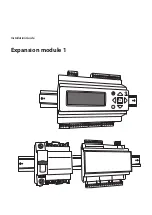
23
Installing the boiler
In the case of service interventions into
the boiler it is unconditionally necessary
whenever the boiler is collected to the
electrical power source (even when the
mains switch of the boiler is off) to abide by
the safety prescriptions for operation and
work on electrical equipment (provision of
norm STN 34 3100).
The boiler casing can be disassembled.
The frontal section is secured by spring
clamps in the upper corners of the casing.
The frontal wall can be folded down by
pulling on the upper corner, the upper
side is folded from the back in an upwards
direction after the removal of two screws.
The remaining parts of the casing are
attached with self-drilling screws to the
boiler chassis. The individual parts of the
casing are connected to the electrical
installation of the boiler by protective
conductors.
Exercise especial caution in transport
handling of the boiler, with regard to the
height of the centre of gravity.
The end pieces for connection are on
the rear side of the boiler (see Fig. 5,
Connection dimensions of boiler).
It is necessary to install a backfl
ow
clack valve and safety valve on the hot
water inlet to the boiler. The clack valve
combined in a single armature is supplied
together with the boiler. The valve
compensates for the volume expansion of
the utility water during heating, and is thus
constantly active, and it is recommended
that water escaping from this is drained by
a permanently installed drainage pipe into
the waste water conduit. It is necessary
for the water to have a smooth passage
of drainage, without any possibility of
accumulation of the drained water. In the
case of a higher pressure of the inlet utility
water then 600 kPa (6 bar) it is necessary
to use a reduction valve before inlet into
the boiler.
Before the combined armature (in the fl ow
direction of the utility water) it is desirable
to install also a stopper, which is not
included in the boiler delivery.
The combined armature is always installed
– however water leakage from the safety
valve in the armature may be resolved
by installing an expansion tank for utility
water. This concerns a “high pressure”
(but not “heating”!) expansion vessel,
which must have a nominal volume of at
least 3 litres and nominal pressure of 600
kPa (6 bar). It must be placed behind the
combined armature (in the fl ow direction
of the water), either in front of or behind
the vessel, in an appropriate place of the
hot water distribution system.
Important:
There must not be any
stoppers or obstacles to the fl ow of water
through the piping between the tank and
the safety valve (combined armature)
and between the tank and the expansion
vessel for the utility water!
In order to ensure that no water leaks
from the safety valve after installation of
the “high pressure” vessel, the resulting
working pressure of the vessel must be
10 to 30 kPa (0.1 to 0.3 bar) lower than
the opening pressure of the valve!
The boiler pipe connection pieces (primarily
for gas) must not be subjected to any
forces from the pipe system of the heating
system or gas inlet. This requires precise
adherence to the dimensions of the end
pieces of the connection pipes, vertically
as well as in terms of the distance from
the wall and the mutual distance between
the individual inlets and outlets.
During reconstructions, in unfavourable
building dispositions, etc., it is possible
to connect the boiler to the heating
system and gas mains by means of
fl exible elements (hoses), but only those
which are designed for this purpose.
Flexible components should be as short
as possible, must be protected against
mechanical and chemical loads and









































